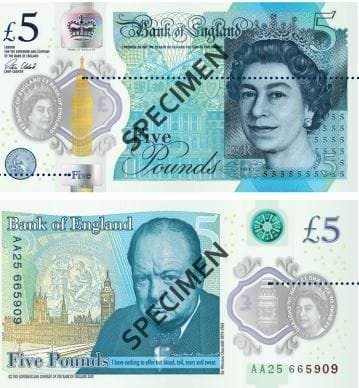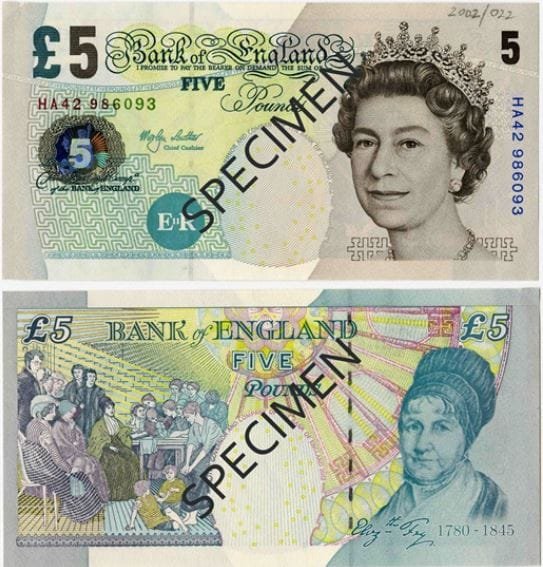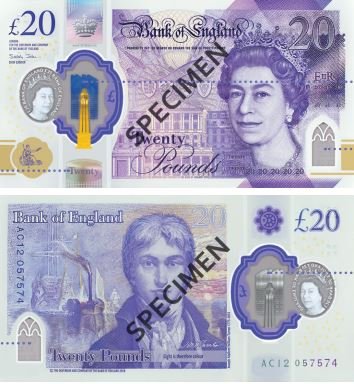What to do with old paper banknotes?
Are you wondering what to do with old money?
Details of the cash still in circulation or hiding in homes were revealed in a Freedom of Information request by BBC Wales.
Their research found that there are paper banknotes worth £18.9bn still in circulation.
Paper £20 and £50 notes cannot be used after 30th September 2022
New £20 and £50 notes made of polymer have been issued and the 30th September 2022 is the last day you can use paper £20 and £50 notes.
There is almost £19bn in old banknotes still being used only six months before paper £20 and £50 notes stop being legal tender.
The paper notes have been replaced with new plastic notes that include a series of new security features.
£5 Note
£5 Banknote Paper Version (withdrawn)
- Date last issued: 2016
- £5 Series E (Variant)
- Date first issued: 21 May 2002
- Date ceased to be legal tender: 5 May 2017
- Colour: Front green, back green
- Size: 5 5/16″ x 2 3/4″ (135mm x 70mm)
- Design: Andy Ward as Chief Designer and design work by Debbie Marriott
£5 Banknote Polymer Version (current)

The first £5 note of the current design was issued in 2016. It features the politician Sir Winston Churchill. The £5 is our lowest-value note.
Are £5 and £10 notes still legal tender?
The paper version of £5 and £10 banknotes have already been withdrawn by The Bank of England. See withdrawn banknotes
Paper version £20 and £50 notes cannot be used after 30 September 2022.
What do the new Polymer Banknotes look like?
£5 Note Polymer – image source The Bank Of England
£10 Polymer Banknote
£20 Polymer Banknote
£50 Polymer Banknote
Take a closer look at The Bank Of England website.
New £20 Note
A short video on the security features of the new £20 notes
What to do with old banknotes?
The Bank of England said it will continue to swap old notes for their face value.
See their guide on Exchanging Old Banknotes
Ask your local bank branch or The Post Office may also accept withdrawn notes as a deposit into any bank account you can access at the Post Office.
How to detect fake banknotes?
To help to fight counterfeit banknotes, The Bank of England has a free Banknote Checking Scheme. Check all notes carefully and join the free Banknote Checking Scheme
How many paper banknotes are still in circulation?
The Bank of England has stated that 775 million paper banknotes remain in circulation.
- 113 million paper £5 notes remain in circulation
- 73 million paper £10 notes remain in circulation
- 360 million paper £20 notes remain in circulation
- 209 million paper £50 notes remain in circulation
The paper £5 notes were withdrawn in May 2017, and the paper £10 notes in March 2018, since when they have not been a legally accepted means of payment.
What’s different about the new plastic £50 notes?
The new plastic £50 note has a series of security features. Also known as the polymer £50 note, it features the portrait of Alan Turing entered circulation on 23 June 2021, meaning the Bank’s entire collection of currently-printed banknotes is made of plastic.
In April 2021, the Bank of Scotland has unveiled the design of its new polymer £50 note which entered circulation on the 1st of July 2021.
For the first time, the famous Falkirk structure will be joined by an image of the shape-shifting water spirits, The Kelpies. The two 300-tonne horses’ heads have been added to the £50 note in celebration of the contribution of horses to the history of Scotland. Furthermore, a new UV feature depicts a horse pulling a canal barge, one of the ways horses shaped the geographical layout of the Falkirk area.
Bank of Scotland’s new £50 notes features the poem ‘Steam Barge’, by William Muir. It was written after he saw the newly-invented steamboat passing through Scotland’s Grand Canal.
The front of the new note portrays the Scottish novelist and poet, Sir Walter Scott, alongside the image of The Mound in Edinburgh, as the current £50 note does today.
The note has important security features which include an anti-counterfeit ‘window effect’ – transparent windows within The Mound frontage and a transparent vertical stripe – on the front of the note. Inside the vertical stripe is a holographic foil strip which displays the ‘Prosperity’ statue on top of The Mound, the bank’s logo, and ’£50.’ The foil also displays a ‘Northern Lights’ effect, with stars and colours resembling the phenomena appearing, when the note is tilted.
In addition, as with the £10 and £20 polymer notes, the £50 note will have a tactile emboss feature, to aid the visually impaired.
While the paper £5 and £10 notes are no longer legal tender, they will always be exchanged by the Bank of England.
A spokeswoman explained that
all genuine Bank of England banknotes that have been withdrawn from circulation retain their face value for all time
People can also post old notes to the bank in Threadneedle Street, in the City of London, to be paid into a bank account, by cheque or, “if you live in the UK and your exchange is worth less than £50”, swapped for new-style polymer ones. Old paper £10 notes and round £1 coins are no longer legal tender
Old notes can also be taken there in person but the bank warns of long queues and waiting times up to an hour.
If you have a UK bank account, the Bank of England said the simplest and quickest way to exchange paper £20 and £50 notes “will normally be to deposit them with your bank”.
How many old one pound coins are still in circulation?
The round £1 coin was demonetised at midnight on 15 October 2017 however, according to the Royal Mint, there are £105m of old one pound coins in circulation.
So in addition to the paper cash, the Royal Mint said about 105 million old-style £1 coins have not been returned.
Out of the 1.6 billion that have been returned, about 1.45 million were fake counterfeits. The round £1 coin was replaced by the 12-sided version in October 2017, to crack down on counterfeiting.
The old-style coin can still be deposited at high street banks – but cannot be spent in shops.
According to the Royal Mint, a company wholly owned by the UK Treasury, about 138 million round £1 coins were melted down to make some of the new ones at its base in Llantrisant in Rhondda Cynon Taf.
The new £1 coin is described by the Mint as the most “secure in the world” and has a string of anti-counterfeiting details, including a hologram, and micro-sized lettering inside both rims.
It also has material inside which can be detected when electronically scanned by coin-counting or payment machines.
£566m worth of £5 paper banknotes remain in circulation
The use of cash fell sharply during the coronavirus pandemic, as lockdowns reduced options for spending. This accelerated a downward trend for the use of notes and coins.
However, cash still accounted for 17% of all payments in 2020, according to the latest available figures by banking trade body UK Finance, making it the second-most-popular way to pay after debit cards. Figures for 2021 will be published this summer.
Remember and share the date with your friends for cash in your paper notes, the 30th of September 2022 is the last day you can use paper for £20 and £50 notes.






